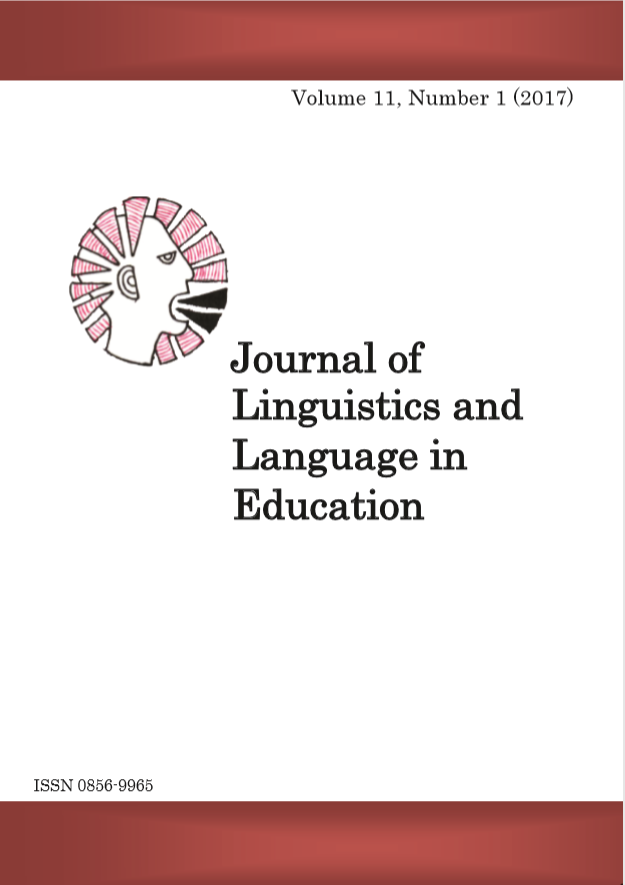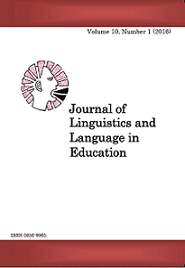Sign Language Policies, Practices and Challenges in Zimbabwe ' s Universities
Abstract
This study examines the teaching and learning of Sign Language in
Zimbabwe with special reference to the national language policy,
current practice and challenges pertaining to its implementation. The
focus is on establishing the medium of instruction that is being used to
teach deaf students and the challenges in interactions that are faced by
both students and lecturers. The data was collected from a sample of
five universities. The findings converge on lack of spelt out
implementation strategies by universities in promoting Sign Language
use and Sign Language instruction in educational institutions in line
with the expectations of statutes espoused in the national constitution.
The universities are yet to roll out Sign Language pedagogy and
promotion through access to education and respect of the basic
linguistic rights that are enjoyed by many of the citizenry in the
country. The selected universities are a representation of both public
and private institutions which would be expected to lead by example in
championing constitutionalism and promotion of local and marginalized
languages. The findings also noted the need for attitude changes by the
general populace if the education system has to embrace Sign Language
as both a medium of instruction and a language subject across
universities, addressing the spirit of inclusive education This study
conscientizes policy makers at both micro and macro levels to walk the
talk and work out strategies for the development of Sign Language.
References
References
Alidou, H., Boly, A. Brocke-Utne, B. Diallo, Y. Heugh, K. & Wolff, H.
(2006). Optimizing Learning and Education in Africa-the
Language Factor: A Stock-taking Research on Mother Tongue
and Bilingual Education in sub-Saharan Africa. Association
for the Development of Education in Africa, Agency for
Technical Cooperation, German.
Bamgbose, A. (1991). Language and Nation: The Language Question
in sub-Saharan Africa. Edinburgh: Edinburgh University
Press.
Bamgbose, A. (2000). Language and Exclusion: The Consequences of
Language Policies in Africa. London: Transaction Publishers.
Bamgbose, A. (2003). Language and the African Renaissance:
Lessons from the South African Experience. In W. Ekkehard
(ed.) Tied Tongues. Berlin Hamburg Munster: Lit Velarg.
Beveridge, S. 1999. Special Education Needs in Schools. London.
Routledge.
Brueggermann, B. J. (2004) Literacy and Deaf People , Washington
DC: Gallaudet University.
Chivero, E. (2012). Language and Gender: A Sociolinguistic Analysis
of Zimbabwean Parliamentary Discourse. Unpublished PhD
Thesis, University of Zimbabwe. Constitution of Zimbabwe
Amendment No. 20 Act. Harare Printers and Refiners (1)
Deaf Zimbabwe Trust. 2013. Position Paper on the Situation
of Deaf Children in Zimbabwe Schools. A Focus on the
Implementation of Sign Language in Teaching Deaf
Children. (Unpublished).
Doyce, M. & Dye, L. (2002). Mainstreaming the Student who is Deaf
or Hard of Hearing. A Guide for Professionals, Teachers and
Parents. CCHAT Centre: San Diego.
Journal of Linguistics and Language in Education Volume 14, Number 2 (2020)|35
Dube, L. & Ncube, B. (2013). Language Policy and Linguistic Rights
in Post-colonial Zimbabwe: The Case of IsiNdebele. Greener
Journal of Social Sciences, 3(5): 249-255.
Education Act, Chapter 25:04, as Amended in (2006). Harare:
Government Printers.
Elliot, K. & Timulak, L. (2005). Descriptive and Interpretive
Approaches to Qualitative Researches. Oxford: Oxford
University Press.
Gora, R.B. (2013). Continuity and Change: Towards a National
Language Policyfor Education in Zimbabwe . [Online]
http://www.onlineresearchjournals. Org/JSS, accessed [2017
October 18].
Gotosa, K. Rwodzi, M. & Mhlanga, G. (2013). Language in
Education: A Critical Review of Current Proposals for
Official Mother Tongue Use in Zimbabwean Classrooms.
International Journal of Humanities and Social Science, 3:
-94.
Gregory, S. (1998) Mathematics and Deaf Children, In S. Gregory, P.
Knight, W. McCracken, S. Powers & L. Watson (eds.). Issues
in Deaf Education, London: David Fulton Publishers.
Johnston, T. (1989). Auslan Dictionary: A Dictionary of Sign
Language of the Australian Community. Peterham: Deafness
Resources Australia.
Kadenge, M. & Mugari, V. (2015). The Current Politics of African
Languages inZimbabwe. Per Linguam, 31(2):21-34.
Kadenge, M. & Nkomo, D. (2011a). The Politics of the English
Language in Zimbabwe. Language Matters: Studies in the
Languages of Africa, 42(2): 248-162.
Kadenge, M. & Nkomo, D. (2011b). Language Policy, Translation and
LanguageDevelopment in Zimbabwe. Southern African
Linguistics and Applied Studies, 29(3): 259-274.
Lin, A. M. Y. (2005). Researchers Positionality. In F. M. Hult & D. C.
Johnson (eds.). Research Methods in Language Policy and
Planning: A Practical Guide . Wiley Blackwell. [Kindle
Paperwhite].
Matende, T. (2018). Language Use in the Legal Process: A Case of SL
in Zimbabwe . Unpublished Masters dissertation).
Department of linguistics, Faculty ofarts, University of
Zimbabwe.
Ministry of Education (2001). Secretary's P.2 Circular . Harare:
Government Printers.
| Sign Language Policies, Practices and Challenges
Ministry of Education, Sports and Culture (2002). Secretary's
Circular P1 of2002: Policy Regarding Language Teaching
and Learning. Harare: Government Printers.
Ministry of Education Sports and Culture (2002). Secretary's
Circular P3 of 2002: Curriculum Policy: Primary and
Secondary Schools. Policy Guidelines on the Teaching and
Learning of Local Languages in Primary and Secondary
Schools in Zimbabwe. Harare: Government Printers.
Morgan, R., Glaser, M. & Magongwa, L. (2016). Constructing and
Rolling out the New South African Sign Language (SASL)
Curriculum €“ Reflexive Critique. Per Linguam 2016,
(2):15-29.
Muchenje, F., Goronga, P. & Bondai, B. (2013). Zimbabwe's
Language Policy in Education and the Silenced Voices. A
Case of Nyanja / Chewa Speaking Pupils from Porta and
Kintyre Primary Schools in Zvimba. Academic Research
International , 4(2) [online] http://www.savap.org. Pk,
accessed [2016, March 15].
Musengi, M. & Chireshe, R. (2012). Inclusion of Deaf Children in
Mainstream Rural Primary Schools in Zimbabwe: Challenges
and Opportunities. Studies of Tribes Tribals , 10(2): 107-116.
Musengi, M. Ndofirepi, A. & Shumba, A. (2012). Rethinking
Education of Deaf Children in Zimbabwe, Challenges and
Opportunities for Teacher Education. Journal of Deaf
Studies and Deaf Education, 18(1): 62-74.
Ndlovu, B. (2014). A Critical Appreciation of the Policy Position and
Practice Regarding the Teaching and Learning of Sign
Language in Primary School Education: The Case of Selected
Schools in Bulawayo. Unpublished Dissertation, University
of Zimbabwe.
Ndlovu, E. (2011). Mother Tongue Education in the Official Minority
of Languages of Zimbabwe: A Language Management
Critique . Unpublished Doctoral Thesis, University of Free
State.
Nziramasanga, C. T. (1999). Report of the Presidential Commission
of Inquiry into Education and Training (CIET). Harare:
Government Printers.
Oyewumi, M. (2008). An Investigation on Inclusive in Structural
Practices and Learning of Students with Hearing
Impairments in Post-Secondary Schools. London: Boston
Houghton Mifflin.
Serpell, R. (2007). Cultural Challenges for the Design of Schooling in
the Urban Neighbourhoods of Baltimore City USA and Rural
Journal of Linguistics and Language in Education Volume 14, Number 2 (2020)|37
Neighbourhoods of Katete District, Zambia. Paper presented
at a symposium on the theme "Towards a School Curriculum
that is Locally and Culturally Appropriate." Geneva,
Switzerland, 28-30 June 2007.
Shi, J. (2015). The Combination of Critical Discourse Analysis and
Ethnography in Language Policy and Planning Study: A
Literature Review. ARECLS, 12(3): 118-137.
Shohamy, E. (2006). Language Policy: Hidden Agendas and New
Approaches. London: Routledge.
Skutnabb-Kangas, T. & Dunbar, R. (2010). Indigenous Children's
Education as Linguistic Genocide and a Crime against
Humanity. A Global View. Galdu Cala Journal of Indigenous
Peoples Rights, 1: 1-3.
Skutnabb-Kangas, T. (2000). Linguistic Genocide in Education or
Worldwide Diversity and Human Rights? Mahwah, N.J: L.
Erlbaum Associates.
Taylor, S. (2004). Researching Educational Policy and Change in
"New Times": Using Critical Discourse Analysis. Journal of
Educational Policy, 33(1): 47-62.
Tollefson, J. W. (2006). Critical Theory in Language Policy. In T.
Ricento (ed.). An Introduction to Language Policy: Theory
and Method. London: Blackwell Publishing.
Wauters, L. N., van Bon, W. H. J. & Tellings, A. E. J. M. (2006).
Reading Comprehension of Dutch Deaf Children, Reading
and Writing: An Interdisciplinary Journal , 19: 49-76.
Wood, D. Wood, H. Griffiths, A. & Howarth, I. (1996). Teaching and
Talking with Deaf Children: Chichester, United Kingdom:
John Wiley and Sons.
http://Umalusi.org.za/docs/reports/2018 South African Sign
Language. Accessed on 12/12/2020
Downloads
Published
Issue
Section
License
Copyright © by Department of Foreign Languages and Linguistics, University of Dar es Salaam
All rights reserved. No part of this publication may be reproduced or transmitted in any form or by any means, electronic or mechanical, including photocopying, recording, or any information storage or retrieval system, without permission in writing from the publisher, except for short extracts in fair dealing, for research or private study, critical scholarly review or discourse with an acknowledgement.



